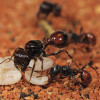The risk of HIV spread between a breastfeeding mother and her infant is strongly linked to weaning, new research has shown. 
About 6% of the babies of untreated HIV-positive mothers will test positive for the virus at birth. But this number rises to 25% among breast-fed infants, indicating that breastmilk is a significant risk factor for disease transmission.
Reflecting this, guidance published by the World Health Organisation suggests that women in poor countries without access to anti-AIDS drugs should breast feed for 4 months only to minimise the transmission risk.
Surprisingly, however, this intervention has had a more modest impact on disease rates than expected.
Now, a trial involving just under 1000 HIV-infected mothers in Zambia, where about 15% of the population are infected, has revealed why.
Writing in Science Translational Medicine, Columbia University's Louise Kuhn and her colleagues randomised the women either to breast feed exclusively for 4 months and then cease abruptly, weaning their infants at the same time, or to breast feed for a duration of their own choosing.
Throughout the trial, infection rates in the babies were monitored regularly, alongside levels of virus in samples of the mothers' blood and breast milk.
Mothers who reduced the frequency of breast feeding, the team found, had up to ten times the amount of virus in their milk compared with women who continued to breastfeed.
The team speculate that when the frequency of breastfeeding alters, to accommodate the introduction of some solid foods for the baby, this has a knock-on effect on the breast tissue, causing unions between cells called tight junctions to open up.
This makes it easier for viruses to leak into the milk from the bloodstream and adjacent parts of the breast.
The result at least partly explains why the HIV infection rate in breastfed infants jumps from 16.8% at age 4 months to 24% after this time.
The weaning process, with non-exclusive breastfeeding, increases the amount of virus in the mother's milk, increasing the risk to the baby.
According to Kuhn and her colleagues, "our results have profound implications for prevention of mother-to-child HIV transmission programmes in settings where breast-feeding is necessary to protect infant and maternal health."
- Previous Music lighting up the pleasure zone
- Next Other habitable planets?










Comments
Add a comment